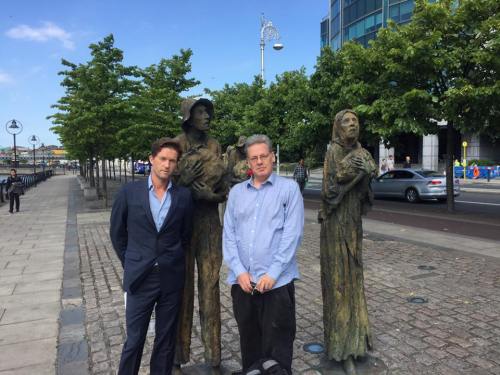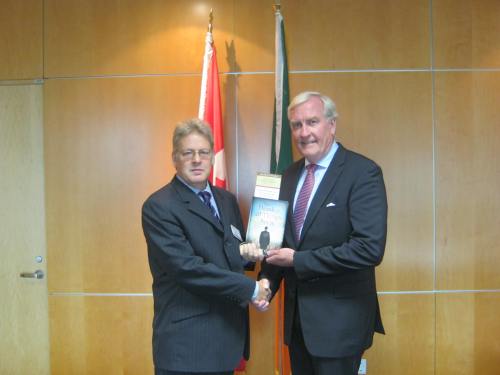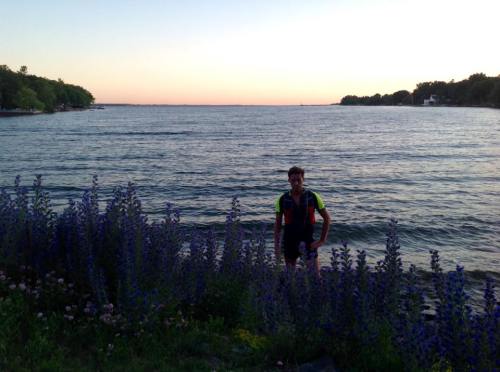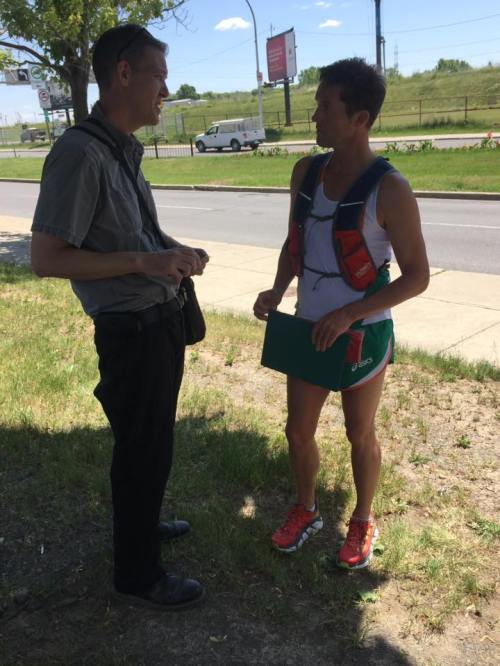National Famine Walk: ‘Remember your soul and your liberty’
From Irish Times (25 May 2017):
National Famine Walk: ‘Remember your soul and your liberty’
Famine scholars are about to follow in the footsteps of the 1,490 tenants forcibly exiled to Canada from Denis Mahon’s Strokestown estate

One of Rowan Gillespie’s Famine statues in Dublin. Photograph: Kate Geraghty

The National Famine Walk will take place over six days from May 27th to June 1st as an international group of Famine scholars follow in the footsteps of the 1,490 tenants from Denis Mahon’s Strokestown Park House estate, who were escorted by a bailiff to Dublin to ensure they boarded ship and left Ireland in 1847.
(Shared here with kind permission of RTÉ News)
The tenants’ fate after they left Dublin is a harrowing one. They travelled on open deck packet steamers to Liverpool, where they waited in the cellars of quayside buildings at Liverpool docks to board ships to Canada. The four ships they boarded – Erin’s Queen, Naomi, The Virginius and The John Munn – were badly fitted out and poorly provisioned. Almost half of those who embarked died aboard ship or in the “fever sheds” at the Grosse Île quarantine station when they arrived in Quebec. Of course, this was not known to them as they walked along the Royal Canal to Dublin, away from hunger and hoping for a better life.
http://nationalfamineway.ie/about-the-1490/crossing-on-the-coffin-ships/
The National Famine Walk begins at one of the numerous points of origin for what has been an ongoing research initiative to document the passage of more than 100,000 tenants forcibly exiled to Canada in 1847. The transatlantic voyage and passage along the Saint Lawrence river from Quebec to Toronto resulted in the second greatest loss of life in the Victorian era, second only to the Crimean War. Of those who left, more than 20,000 perished at sea or along the Saint Lawrence River, marking Canada with the infamous distinction of having the largest Irish mass graves outside of Ireland.
The 1847 evictions, transfer and passage to Canada encapsulate a twice-told tale.
First, it’s a story of British government and Irish landlord neglect. Mahon evicted 3,006 tenants and paid just under £4,000 for the passage of almost 1,000 of those he assisted to emigrate. For his unfailing cruelty, on November 2nd, 1847, Mahon was shot to death as he travelled home to Strokestown House from a Board of Guardians meeting. Murder was not a deterrent for the landlords. Evictions continued until some 11,000 persons of the 12,000 tenants were removed from Mahon’s estate.

In exporting evicted tenants, passage to Canada proved the cheaper alternative to America, given that the American authorities, anticipating the influx of a starving flotsam of Irish, amended their maritime Passenger Acts. Imposing stricter regulations, the acts barred disease-ridden ships from arriving into American ports. In 1847, the most destitute Irish emigrants were sent to the British North American colonies in New Brunswick and Canada East and West (Quebec and Ontario) on retrofitted lumber vessels as human ballast. These coffin ships averaged over 300 persons per vessel, three times that allowed under the American Passenger Acts. Mortality rates approached 40 per cent.
The story of emigration to Canada is, secondly, a contrasting one of succour and sacrifice, as a predominantly Catholic, French Canadian province of Quebec braced for and ministered to a dispossessed, disease-ravaged people in one of the greatest unrecognised human refugee crises of the 19th century.
The immigrant numbers are extraordinary. Most of them arrived at Grosse Île in Quebec, which is now a National Historic Site with a glass wall memorial for the 5,000 Irish interred in mass graves on the island. Grosse Île is twinned with the Irish National Famine Museum at Strokestown Park House, where Taoiseach Enda Kenny unveiled a similar glass wall memorial to its missing 1,490 emigrants in 2014.


Many of those 1,490 emigrants died on Grosse Île. It was there that James Quinn, a 45-year-old Irish emigrant from Lissonuffy, on the Strokestown Park estate, whispered his dying words to his two young sons, Patrick (12) and Thomas (6): “Remember your soul and your liberty”.
The orphaned Quinn brothers were adopted by a French-Canadian family who gave them a good education. They both entered the seminary and became priests with joint French and Irish congregations. In 1877, Patrick Quinn founded the still flourishing St. Patrick Society in Richmond, Quebec, where there is a theatre named after him. His younger brother, Thomas Quinn, became a champion for his French-Canadian parishioners.


At the First Congress of the French Language in Quebec City, on June 25th, 1912, Thomas Quinn thanked the French-Canadian people for their generosity. In a speech entitled “Une Voix d’Irlande” (A Voice of Ireland), he declared in French:
“It was in 1847. A famine, even worse than the one which had preceded it, threatened the Irish people with total extinction. The most astonishing part of the awful spectacle was, not to see the people die, but to see them live through such great distress. Like walking skeletons they went, in tears, seeking hospitality from more favoured lands. Stirred with compassion, French-Canadian priests, braving the epidemic, contended for the glory of rushing to their relief. I still remember one of these admirable clergymen who led us to the bedside of my dying father. As he saw us, my father with his failing voice repeated the old Irish adage, ‘Remember your soul and your liberty’.”
http://nationalfamineway.ie/about-the-1490/the-story-of-the-1490/
Like the Quinn brothers, Daniel and Catherine Tighe also sailed to Grosse Île where they were orphaned, adopted by a French-Canadian family, and allowed to keep their Irish surname. In 2000, Jim Callery, founder of the Irish National Famine Museum, visited Daniel’s son Léo Tye in rural Quebec and heard the story that inspired the search for the missing 1,490 Strokestown emigrants. He also unveiled a Celtic Cross Famine memorial in Quebec City that he had donated on behalf of the Famine Museum. In July 2013, Léo’s son Richard Tye made a return visit from Quebec to Strokestown, and was reunited with the Irish branch of the family. His Irish cousin Philip Tighe will be on the National Famine Walk.

The suffering of Famine emigrants was not confined to Grosse Île. With the arrival of 75,000 typhus-afflicted refugees, the city of Montreal, then a city of 50,000, hastily erected fever sheds to contain disease. The Annals of the Grey Nuns, a recently translated cache of diaries, details the convergence of municipal and religious groups involved in saving Irish lives, often at great personal cost. Notable casualties included the Protestant mayor of Montreal and myriad priests and nuns who worked the fever sheds of Pointe Sainte Charles.

In the wake of the emigrant passing through Montreal, over 3,000 Irish orphan children left in the care of religious orders were eventually adopted, like the Quinn and Tighe siblings, into French-Canadian families.
The journey onward into Ontario has its own history. Less a story of commonality and religious succour, the death toll is lower, given how most afflicted died at Grosse Île and Montreal. Also, a subtle sectionalism led to journalistic self-censorship in accurately chronicling the passage and burial of those who died along riverside towns throughout Ontario.
Such was the forgotten history of Canadian involvement with the fated year of 1847, simply because the crisis and sacrifice had happened so far away, within a single season. For the most part, accounts of the worst suffering were recorded in French, so the episode closed in the forgotten reaches of Quebec. That is, until recently.
In 2016, Irish author and ultra-runner Michael Collins ran a marathon-a-day for a month from Grosse Île to Toronto; he was inspired by his reading of the Grey Nuns’ annals. En route, along the Saint Lawrence, he met historical societies researching their town’s archives and recorded anecdotal stories passed down by descendants, which he documented on his Irish Diaspora Run 2016 Facebook page. More than 100,000 people visited the page during the run, and he has reactivated it for the National Famine Walk.

http://faminearchive.nuigalway.ie/
The project continues. At Grosse Île quarantine station, a memorial serves as a cautionary reminder of what can befall a dispossessed people, and at the terminus of the route in Toronto, Ireland Park has become a place of pilgrimage, memorialising the passage of 1847. Situated along Toronto’s docklands, a series of Rowan Gillespie Famine sculptures reach back across the ocean to Gillespie’s Famine sculptures on Dublin’s Custom House Quay Docklands. Without descriptive plaques detailing the history of 1847, the sculptures simultaneously encompass and transcend Irish history, evoking the universality of the immigrant experience, both past and present. In the furtherance of peace, Ireland Park Foundation has reconfigured a national tragedy, not as a source of differentiation, but of shared experience. In 2017, the foundation will unveil Dr George Robert Grasett Park, celebrating the efforts of the Canadian medical profession which so tirelessly worked to save both those who arrived and Toronto’s own citizens from disease.

What remains yet to be memorialised is Montreal’s response to 1847. Specifically, The Black Rock memorial, a stone hastily erected by workmen who uncovered over 6,000 bodies during the 1859 construction of the Victoria Bridge, lies in the median of a major arterial in downtown Montreal and is in jeopardy of being summarily removed as the city plans a major overhaul of the area. The Montreal Irish Monument Park Foundation is locked in a tenuous battle with city, provincial and federal authorities to preserve and allocate what is currently an abandoned parking lot as the future site of a memorial grounds honoring both the 1847 emigrants and those who came to their aid.


The National Famine Walk complements these projects to ensure that Famine emigrants like Strokestown’s missing 1,490 are commemorated on both sides of the Atlantic. In following in their footsteps, the walkers are not only honouring their legacy. They are embarking on a journey to trace the descendants of the 1,490 emigrants in Canada and the United States, especially from Irish Famine orphans adopted in Quebec. They are also laying the foundation for a permanent walking trail along the Royal Canal between Strokestown and Dublin, the National Famine Way. With its advent, hitherto inaccessible paths are providing opportunities to walk in the footsteps of the dispossessed.
Prof. Christine Kinealy (and founding director of the Ireland’s Great Hunger Institute at Quinnipiac University) talks to ADAPT about the cultural impact of the great famine and how it influenced Ireland in years to come.
Author Cathal Poirteir tells about the particular character from the 1,490 who left Strokestown, one John O’Connor. His story is a tragic one as he died during the famine, but not from hunger!
The Famine walkers’ journey from May 27th to June 1st can be followed in real time at http://www.nationalfamineway.ie.
Famine Way Walkers Re-enact the arrival of the 1,490 at Spencer Dock, Dublin.
Having waked from Strokestown, Co Roscommon, Famine Way Walkers 2018 re-enact the final steps journey of 1490 migrant tenants from Strokestown as they made their way towards the replica famine ship, the Jeanie Johnston. This is a playlist of three short but separate videos.
The National Famine Way is being developed by Strokestown Park House, the Irish National Famine Museum, and the Irish Heritage Trust in partnership with Waterways Ireland, the ADAPT Centre for Digital Content Technology, Ireland’s Great Hunger Institute at Quinnipiac University, Ireland Park Foundation, the University of Toronto, Royal Canal Amenity Group, Roscommon and Longford County Councils, and Strokestown Community Town Team.

































 Michael Collins completes Irish Diaspora Run 2016 at Ireland Park in Toronto.
Michael Collins completes Irish Diaspora Run 2016 at Ireland Park in Toronto.






 Michael Collins with his family at Ireland Park in Toronto, the final destination of his Irish Diaspora Run. Patrick James White and Michael Collins at Courtice, Ontario
Michael Collins with his family at Ireland Park in Toronto, the final destination of his Irish Diaspora Run. Patrick James White and Michael Collins at Courtice, Ontario
 Total miles run, overall time and calories burned by Michael Collins on his Diaspora Run.
Total miles run, overall time and calories burned by Michael Collins on his Diaspora Run.
 Patrick James White and Michael Collins at Courtice, Ontario.
Patrick James White and Michael Collins at Courtice, Ontario.
 Coffin Ship memorial in Ireland Park, Toronto.
Coffin Ship memorial in Ireland Park, Toronto.


























